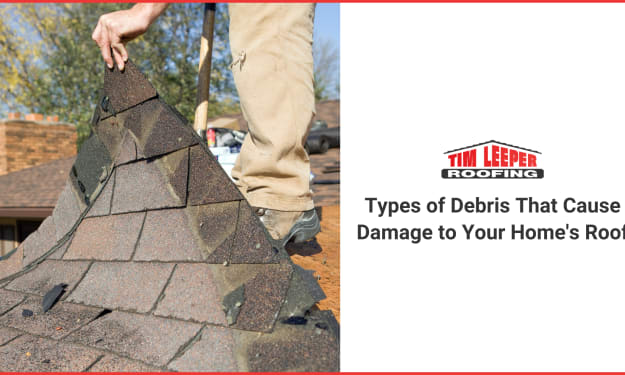How Storm Damages Roofs and What to Do About It?
No matter where you live, chances of encountering storm damage to your roof exist. Read the blog to know how these damages can be addressed with professional help.

Nature may be full of beauty, but its whims can cause significant damage to our Nashville homes. From summer storms that bring driving rain and wind to hail storms and hurricanes, roof damage from these extreme weather conditions is an all-too-common reality for many homeowners, no matter where they live.
It is hard to spot storm damage if you are a homeowner who doesn't spend most of their days on top of a roof and standing on the ground looking up. But with an expert eye, a professional Nashville roofer can quickly and easily identify damage that might otherwise go unnoticed.
As your home's roof is the first line of defense against the strong winds, heavy rains, scorching sun, and massive snowfall that takes a beating 365 days a year, understanding the proper steps to take after storm damage is essential.
With that in mind, read the blog post to explore how storm damage affects roofs and what you should do to mitigate the damage. Let's dive in!
How Does a Storm Damage Your Roof?
Have you ever been through a big storm and noticed damage to your windows and siding? But did you know that the damage to your roof can be even harder to see? Even if you notice some missing shingles, more damage could be hidden underneath.
Storms can be really strong and cause a lot of damage that's not immediately visible. That's why it's a good idea to have a professional check your roof after a big storm is a good idea. They can spot any damage you might have missed and help you fix it before it gets worse.
Why is Damage Hard to Spot Without Professional Roof Inspection?
If you're not trained in car mechanics, you might be unable to tell the difference between a faulty brake system and a worn-out tire. Similarly, if you're not trained in roof repair, you might not be able to spot damage to your shingles.
That's where professional roofers come in. As experts in roof repair, they understand the nuances of damage that can occur on a roof. For instance, hailstones can cause significant damage to a roof, even if it's not immediately visible. While the top layer of shingles might look fine, hail can puncture or crack the shingle, exposing the underlayment and leading to leaks in the future.
Over time, the damage caused by hail can worsen, especially during heavy rain or snowfall. This can lead to more significant issues like water damage, mold, and even structural damage to the home. That's why it's crucial to have a professional Nashville roofing expert inspect your roof after a hailstorm and fix any damage as soon as possible.
What Types of Roof Damage Occur Due to Storms?
If a storm passes through your area, it can cause several types of damage. Knowing these types of roof damage due to storms can help you be better prepared about what to look for and what action you can take to protect your roof. These include:
Wind Damage
Hang on to your hat – when strong winds blow, your roof is in danger! Powerful hurricane-force winds, which can whip up at 74 mph or higher, or even gale-force winds, ranging from 39-54 mph, can wreak havoc on your roof. These gusts can rip shingles right off your roof, exposing the underlayment, roof deck, or waterproofing material to harsh elements.
But even in less intense storms, gusts of wind can still cause problems. Suddenly lifting and curling shingles may not seem like a big deal, but when your roof is installed, shingles are overlapped to create a tight seal that protects your home from water damage. Any lifting or curling can break this seal and open your roof to wind-driven rain and potential damage.
Hail Damage
Hailstones may seem harmless, but they can wreak havoc on your roof in just a matter of minutes. These frozen balls of precipitation can leave your shingles dented and damaged, creating unsightly pockmarks that ruin the smooth surface of your roof.
But the damage doesn't stop there. Hailstones can also knock loose the granules that cover your shingles. These granules help protect your roof from rain and sun damage, so losing them can leave your roof vulnerable to further harm.
Rain Damage
The most common and noticeable of all types of storm damage, rain roof damage occurs when your roof cannot withstand the amount of rain and snow it is exposed to. Leaks, mold, rot, and structural damage are all signs of rain damage. To prevent rain damage from occurring, you should make sure that your roof is well-maintained and inspected for any signs of aging or wear.
Standing Water Damage
If no proper drainage system is installed on your roof, standing water can accumulate after big rainstorms. This can cause flooding and other problems on the roof deck, such as water seeping into the underlayment and damaging it from within. To prevent this from happening, it's essential to ensure that your gutters are clear so that water can flow freely off the roof.
Debris Damage
Depending on the storm's severity, debris, such as branches and leaves, may end up on your roof. When left to accumulate, this debris can trap moisture against the shingles and cause them to rot or erode away over time.
What Steps Should You Take When Your Roof Suffers Storm Damage?
Now that you know the types of storm damage your roof can suffer, it's important to understand what steps you should take when it has sustained damage. Read further to learn about the steps you should take.
Assessment of Potential Damage
When you experience severe weather, it is important to assess the damage that has been done to your roof. Roofing contractors can help you discuss the details of the damage and avoid unforeseen costs or discrepancies that can occur.
To assess the damage, you can use binoculars to look at the roof from a distance or use these experts' help to get estimated square footage and note any areas with missing shingles. Additionally, the color and approximate shade of exposed materials should be documented. Once thoroughly assessed the damage, you can discuss roof repair and replacement options with your roofing contractor.
Making Temporary Repairs To Minimize Damage
The roof can be temporarily repaired to minimize any further damage. The goal of a temporary repair is to ensure that no more water gets into the house's interior and causes further destruction. This can be done by tarping over an area or shingling it immediately. It's important to ensure that these repairs are done properly and securely to prevent further water damage.
Scheduling and Conducting a Roof Inspection
Safety should always be a priority when it comes to roof inspections. Contact a trained and trusted roofing contractor to schedule a comprehensive roof inspection and help assess any storm damage.
It is important to visually inspect the roof by walking around the perimeter of your house and looking for any obvious signs of storm damage, such as dented, torn, curled, or missing shingles. Gutters and windows or interior ceilings should also be checked for dents, cracks, water spots, or other signs of damage. Once the roof inspection has been completed, your contractor can provide you with a detailed report outlining any damage and possible roof repair Nashville options.
Hiring Qualified Roofing Contractors to Repair The Roof
Working with a contractor you can trust and rely on is paramount when protecting your home's value. If you've decided to repair your roof, you must find a reliable and qualified roofing contractor who can get the job done right.
When researching different contractors, ask about their experience and qualifications and check reviews left by their previous customers. Work only with contractors who have the proper licensing and follow safety protocols. With a professional eye assessing the damage and estimating roof repair costs, you can feel confident that your roof will be repaired or replaced correctly.
Considering Roof Replacement Option if Necessary
You may need to consider a roof replacement if there is extensive storm damage. Suppose the storm left behind broken shingles, exposed underlayment, or even holes in your roofing material. In that case, it's best to seek a professional and get their opinion on whether you can repair this damage or if it is time for a full replacement. You can ask your roofing contractors for the designs and materials best suited for your roof's replacement and the most cost-effective option for you.
Final Thoughts
At the end of the day, peace of mind and safety are all that really matter when it comes to roof repairs. That's why it's important to trust a qualified, experienced professional. Someone who understands the nuances of shingle damage and can correctly diagnose any repairs needed before they become a greater issue down the road. Don't wait until it's too late - trust your Nashville roofer for all your roofing needs and keep the roof on your head safe and secure!
About the Creator
Tim Leeper Roofing
Leading roofing contractors in Middle Tennessee - Tim Leeper Roofing. We provide roofing replacement and repair services for residential and commercial buildings in Nashville.
Visit our website: https://timleeperroofing.com/






Comments
There are no comments for this story
Be the first to respond and start the conversation.